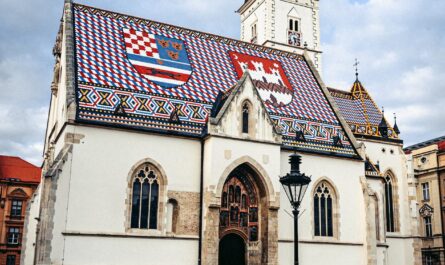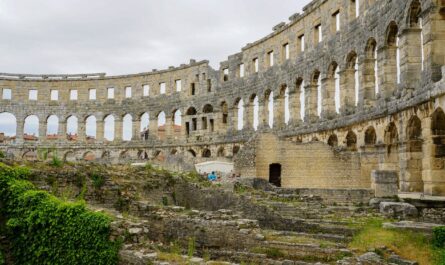Introduction
Bulgaria, a country steeped in history and rich in cultural heritage, boasts a city that stands as a testament to its ancient roots — Plovdiv. Located in the heart of the Thracian Valley, Plovdiv is not just a city; it’s a living museum, where every cobblestone tells a story, and every building echoes the whispers of the past. In this blog post, we will delve into the captivating history, vibrant culture, and enchanting attractions that make Plovdiv a must-visit destination for history enthusiasts and curious travelers alike.
A Journey Through Time
Plovdiv, one of the oldest continuously inhabited cities in Europe, traces its roots back to 6,000 years ago. The city’s history is a fascinating tapestry woven with threads of Thracian, Roman, Byzantine, Ottoman, and Bulgarian influences. Walking through Plovdiv’s Old Town feels like stepping into a time machine, where the layers of history are palpable.
The Old Town: A Stroll Through Antiquity
The heart of Plovdiv lies in its Old Town, an architectural marvel where past and present coalesce. The cobblestone streets wind their way through a maze of well-preserved Revival-era houses, each adorned with colorful facades and intricate wooden detailing. The ethereal beauty of the Old Town earned Plovdiv the title of European Capital of Culture in 2019, bringing international attention to its timeless charm.
One cannot miss the iconic Roman Theater, a structure that transcends centuries. Dating back to the 2nd century AD, this ancient amphitheater once hosted gladiator games and theatrical performances. Today, it serves as a venue for cultural events and concerts, its stone steps echoing with the applause of a modern audience.
Kapana: Where Tradition Meets Innovation
Plovdiv isn’t just about the past; it’s a city that seamlessly blends tradition with modernity. Kapana, a vibrant district within the Old Town, exemplifies this fusion. Once a craftsmen’s quarter, Kapana has evolved into a trendy area filled with art galleries, boutiques, and hip cafes. The narrow streets buzz with creative energy, making it a perfect spot to witness the dynamic spirit of contemporary Plovdiv.
Hidden Wonders and Unique Facts about Plovdiv
The Ancient Stadium
Beyond the well-known Roman Theater, Plovdiv hides another ancient gem—the Ancient Stadium. Unearthed during construction work in the 20th century, this colossal stadium once hosted athletic competitions and could accommodate up to 30,000 spectators. Today, visitors can stroll along the remnants of the stadium and envision the fervor of ancient sports events.
The Nebet Tepe Hill Mystique
Plovdiv’s enchanting landscape includes several hills, among them Nebet Tepe, which has been inhabited since prehistoric times. This hill offers not only panoramic views of the city but also a glimpse into Plovdiv’s ancient past. Excavations have revealed layers of history, from Thracian fortifications to medieval structures, making Nebet Tepe a captivating archaeological site.
The Singing Fountains of Tsar Simeon’s Garden
Tsar Simeon’s Garden, a green oasis in the heart of Plovdiv, is home to the mesmerizing Singing Fountains. These fountains come alive in the evenings with a harmonious display of water, light, and music, creating a magical atmosphere. Locals and tourists alike gather to enjoy the spectacle, making it a delightful experience for all ages.
Plovdiv’s Claim to the World’s Oldest City Title
Plovdiv proudly claims to be one of the oldest continuously inhabited cities in the world, with a history dating back to 4,000 BCE. This assertion is supported by archaeological evidence, making Plovdiv a living testament to human civilization’s enduring presence on the Thracian Plain.
The Ethnographic Museum: Time-Travel Through Bulgarian Traditions
The Ethnographic Museum in Plovdiv is a treasure trove of Bulgarian cultural heritage. Housed in a beautifully preserved 19th-century house, the museum showcases traditional costumes, crafts, and artifacts, providing visitors with a vivid insight into the daily lives of Bulgarians over the centuries.
The Dzhumaya Mosque and Religious Harmony
Plovdiv is a city where diverse religious and cultural influences coexist harmoniously. The Dzhumaya Mosque, a striking example of Ottoman architecture, stands in the heart of the city. Its location reflects the city’s religious tolerance, as the mosque is surrounded by Christian churches, illustrating the unity in diversity that defines Plovdiv.
Plovdiv’s Revival Architecture Renaissance
The Revival Period in Bulgaria left an indelible mark on Plovdiv’s architecture. The cityscape is adorned with beautifully restored Revival-era houses, featuring distinct architectural elements such as overhanging eaves, colorful facades, and ornate wooden carvings. Walking through these streets is like stepping into a living museum of 19th-century Bulgarian urban design.
The Rowing Canal: A Modern Recreational Haven
While Plovdiv cherishes its ancient heritage, it also embraces modernity. The Rowing Canal, constructed for the 1981 World Rowing Championships, has become a popular spot for outdoor activities. Locals and visitors enjoy strolling along the canal, cycling, or indulging in water sports, providing a contemporary recreational dimension to Plovdiv’s diverse offerings.
Cultural Heritage Unveiled
Plovdiv’s commitment to preserving its cultural heritage is evident in its many museums. The Plovdiv Regional Historical Museum, housed in a magnificent 19th-century building, offers a comprehensive journey through the city’s past. From Thracian artifacts to Roman mosaics, the exhibits narrate the story of Plovdiv’s evolution over millennia.
For art enthusiasts, the City Art Gallery showcases a diverse collection of Bulgarian art, featuring both classical and contemporary pieces. The gallery not only provides a visual feast but also serves as a testament to the enduring creativity that defines Plovdiv.
A Taste of Plovdiv
No exploration of a city is complete without savoring its culinary delights. Plovdiv’s culinary scene is a harmonious blend of traditional Bulgarian dishes and modern gastronomic experiences. Local taverns, known as “mehanas,” offer an authentic taste of Bulgarian cuisine, with dishes like kavarma (slow-cooked meat and vegetables) and banitsa (a flaky pastry filled with cheese or spinach).
For those seeking a more eclectic dining experience, Plovdiv boasts a variety of international restaurants and trendy cafes. The city’s diverse food scene reflects its openness to global influences while preserving the authenticity of Bulgarian flavors.
Festivals and Celebrations
Plovdiv comes alive with festivals and celebrations that showcase its cultural vibrancy. The annual Kapana Fest transforms the district into an open-air stage, featuring live performances, art installations, and a lively atmosphere. The International Fair in Plovdiv, dating back to 1892, is another iconic event that attracts visitors from around the world. These festivities not only celebrate the city’s heritage but also invite people to participate in the ongoing narrative of Plovdiv’s cultural identity.
Conclusion
In the heart of Bulgaria, Plovdiv stands as a living testament to the endurance of history and the beauty of cultural diversity. With its ancient charm, vibrant modernity, and a commitment to preserving its heritage, Plovdiv beckons travelers to embark on a journey through time. Whether wandering through the Old Town’s cobblestone streets or savoring the flavors of Bulgarian cuisine, every moment in Plovdiv is an opportunity to connect with the past and embrace the present. As the sun sets over the hills of this ancient gem, Plovdiv whispers its stories to those who are willing to listen, inviting them to become a part of its rich tapestry.




